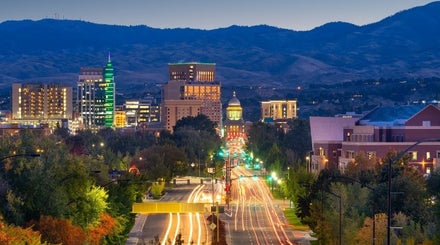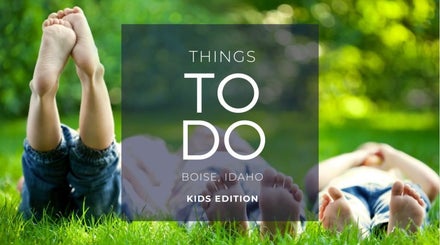
Spend a few days in Boise and it’s easy to understand why it has topped lists for the past few years as one of the fastest-growing cities in the nation. The city’s low cost of living, an impressive array of breweries and restaurants, and diverse recreation activities are just a handful of reasons Boise has dominated national “best of” lists for the last decade. They’re also why people of all ages are choosing to call Boise home.
And with the Boise metro population projected to surpass one million residents by 2040, it’s worth taking a look at who’s migrating to the area. Where are they moving from, and what can our projected population growth tell us about the Treasure Valley’s future?
Metro Boise, Idaho Population
Boise
241,590
Eagle
34,470
Garden City
12,570
Kuna
27,570
Meridian
127,890
Star
13,400
Ada County Total
518,300
Treasure Valley Total
761,680
COMPASS Metro Boise population estimates (updated April 2021)
Decades of Population Growth: Boise’s Humble Past to the National Spotlight
If you ask locals to pinpoint the moment that put Boise on the map, many will reference the July 1992 edition of Outside magazine, which featured a photo of bicyclists riding through the North End’s historic Hyde Park, along with the caption “Where to Live.” At that time, Boise’s population was around 126,000 residents.
The article highlighted many of the natural gems those living in Boise took for granted: a fishable river running right through downtown, flanked by a 26-mile Greenbelt. Boise’s weather – hot and dry in the summer, perfect for camping and recreating; cold and snowy in the winter, with a ski resort less than 20 miles away – was also a draw.
A lot has changed in the last three decades, and those changes have only added to Boise’s attractiveness as a recreation destination. For instance, trail users, land activists and government groups got together in the 1990's to turn Boise’s informal 90 miles of foothills trails into something larger and more sustainable for all users. The Ridge to Rivers trail system now features almost 200 miles of paths suitable for biking, hiking, running, and even horseback riding.
Boise has also made a name for itself as a craft beer destination. We may be famous for potatoes, but Idaho is also the largest producer of barley in the nation and the second-largest producer of hops. Capitalizing on its home-grown appeal, breweries have flourished, especially in the Treasure Valley. In 2019, Idaho had the third-largest growth in brewery employment in the U.S.
Add to that our comparatively lower housing costs, low startup costs, shorter commutes, and slower pace of living, and it’s no wonder Boise has been named the best place for millennials to live, one of the best places to start a business, and one of the best cities to retire, all in the past two years alone. That just about covers everyone living.
Which explains why Boise’s population has exploded from 125,738 to 236,310 residents since the early '90s. In the past decade alone, the city has experienced a 9.3 percent increase in growth, according to the U.S. Census Bureau. (During this time frame, comparable cities in the northwest like Spokane, Washington, and Salt Lake City, Utah, only experienced 6% and 7.6% growth, respectively.)

Most New Boise Residents Are Idahoans
So who’s moving here, and where are they coming from?
Everyone loves a villain, and in Idaho, Californians are an easy target. Skyrocketing housing costs in California are prompting some residents to take flight to neighboring states, including Idaho (which, in turn, raises home prices here).
It is true that many Californians are choosing to move to Idaho for the very reasons we just outlined. But according to the U.S. Census Bureau data, Californians aren’t the predominant group moving to Ada County, which encompasses Boise. The majority of people who moved into Ada County between 2013-2017 were Idahoans – most notably from neighboring Canyon County. During those four years, 9,260 Idahoans moved to Ada County, while only 5,593 Californians relocated.
(Anecdotally, every week WeKnowBoise.com receives visitors from all 50 states, but the vast majority of our traffic is from the Treasure Valley.)
In other words, Idaho’s rural residents are flocking to the state’s largest metropolitan area, likely for its education and employment opportunities.
That isn’t to say that Californians aren’t moving to Idaho – they are. In 2018, Californians were the biggest out-of-state population relocating to Idaho with 21,018 new residents out of nearly 80,000 (or 26.3% of the state’s population growth for that year). But residents from Washington and Utah made up another 18.7% and 8.3% of Idaho’s population growth spurt, respectively.
Top Sources of Inbound Migration to Ada County
- Canyon County, Idaho
- Utah County, Utah
- Bannock County, Idaho
- San Diego County, California
- Twin Falls County, Idaho
- Orange County, California
- Los Angeles County, California
- Riverside County, California
- Latah County, Idaho
- Blaine County, Idaho
Between 2013 and 2017, 9,260 Idahoans moved to Ada County. 5,593 people moved from California, followed by roughly 2,000 more each from Washington, Utah, and Oregon.
What Strong Population Growth Means for Boise’s Future
Many of the reasons that make Boise an attractive place to live aren’t going away any time soon. We can reasonably assume that as nice as Boise is, more people are going to want to live here.
This popularity extends beyond Boise – neighboring Meridian’s population growth is also outpacing much of the nation. It was named one of the fastest-growing cities in the U.S. in 2019. In fact, the Boise metro area was ranked the 8th fastest growing in the country in 2019, according to the U.S. Census Bureau data.
What does this mean for the Boise real estate market?
It means that demand for housing in Boise and the greater Treasure Valley isn’t going to let up any time soon. It’s anticipated that much of the valley’s agricultural land will be converted to new construction to try and keep up with the demand for housing.
In the meantime, tight housing stock and high prices are likely to be the region’s new normal for the foreseeable future. That can be great news for those looking to sell in this market. However, it also makes housing affordability a more pressing issue in the Treasure Valley. Not to mention, it can make it more difficult for first-time homebuyers to find something in their price range.







Leave A Comment